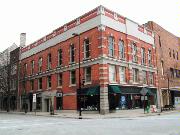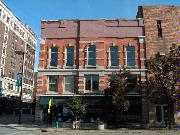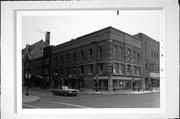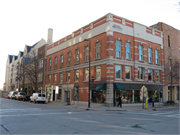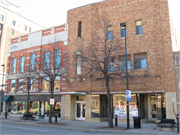Property Record
300-304 PINE ST
Architecture and History Inventory
| Historic Name: | Shaylor Block |
|---|---|
| Other Name: | E.J. Shaylor Block, The Little Shop |
| Contributing: | Yes |
| Reference Number: | 35433 |
| Location (Address): | 300-304 PINE ST |
|---|---|
| County: | Brown |
| City: | Green Bay |
| Township/Village: | |
| Unincorporated Community: | |
| Town: | |
| Range: | |
| Direction: | |
| Section: | |
| Quarter Section: | |
| Quarter/Quarter Section: |
| Year Built: | 1872 |
|---|---|
| Additions: | |
| Survey Date: | 19852017 |
| Historic Use: | small office building |
| Architectural Style: | Commercial Vernacular |
| Structural System: | |
| Wall Material: | Brick |
| Architect: | William Waters |
| Other Buildings On Site: | |
| Demolished?: | No |
| Demolished Date: |
| National/State Register Listing Name: | Green Bay Downtown Historic District |
|---|---|
| National Register Listing Date: | 5/13/2019 |
| State Register Listing Date: | 2/16/2018 |
| National Register Multiple Property Name: |
| Additional Information: | Historic photos show that this building has been substantially altered over the years. Originally the building was encircled by four wide cut stone bands, the first being the foundation; the second served as the lintels of the first floor windows set in the tall raised foundation. The third is intact as a wide beltcourse above today's 2nd floor windows; and the fourth was a massive entabluature with denticulated blocks below the cornice. The main facade of the building was on N. Adams St. All of today's 3rd floor windows are semi-circular arched and tall cut stone steps give entrance to the building from the street into what is now the central window of the slightly projecting bay on the N. Adams St. facade. Over time, the entrance shifted to Pine St. The 1st floor windows were changed to display windows. The 2nd floor wndows became flat arched and the entire cornice and parapet were replaced. This building is believed to be the one Waters designed for Shaylor to house the office of the Green Bay and Lake Pepin Railroad. 2017-NRHP District Nomination This three-story brick building was designed by William Waters, a prominent architect from Oshkosh, and built in 1872. The building sits on the southeast corner of N. Adams and Pine Streets; it has been home to several businesses over the years, including the Gazette Publishing Company beginning in 1907. The building has been substantially altered since its construction, but those alterations have occurred during the historic period of the district. As constructed, this brick, vernacular commercial building had four wide, cut stone bands, that divided the building into three vertical portions. The bottom band served as the foundation. A second band served as a continuous lintel shared by the first-floor windows, themselves set in tall brick foundation walls. Access to this first floor was via doors on N. Adams Street, with stairs leading up to the sidewalk. The third band remains intact as a wide beltcourse above the second story windows. The fourth band was a massive entablature with heavy, dentil-like modillions and paired corbels. The entablature remains today as a plain horizontal band, but all modillions, corbels, cornice, and associated moldings have been removed. A uniform-height brick parapet, consisting of brickwork panels separated by brick piers, remains largely unaltered, although a taller, central portion of the parapet along N. Adams Street was removed. All second-story windows originally had semi-circular arched tops with keystones above. The central entrance, then on N. Adams Street, was recessed under a large arch, the top of which was at the same height as the second story windows. That entrance included a staircase rising from the sidewalk to the second story where the entrance door was located. Major alterations to this building were contemplated by the Greiling Brothers in 1905. A photograph of the recently completed Architects Building (306-314 Pine), built in 1928, shows that all second story windows along Pine Street had been altered to the rectangular form present today. This photograph also shows a taller first floor and removal of the first story lintel band. This did away with the need for the below-grade entrance doors. A 1912 photograph suggests that these changes may not have yet been made, but the visual evidence is not entirely clear. Additional photographic evidence shows that the building’s massive entablature was altered to its present form after 1928 and before the mid-1950s. Today, the N. Adams Street façade has two-story brick and stone piers at either end which appear to be unaltered from their 1870s appearance. The first-floor storefront is completely altered, with large glass windows extending from the foundation near the sidewalk up to a band of metal paneling above A recessed entrance has been constructed at the left corner and a second entrance is right of center in the façade. The second story is divided into three bays. The narrow center bay is defined by original brick and stonework that once defined the archway, but has since been opened to create a rectangular opening. Large corbels now support the brick and stonework window surround, and paired 1/1 windows occupy the space where the top of the arch once was. The top of the central window opening is the beltcourse above the second story windows which now visually serves as a continuous shared lintel for all second story windows. A pair of 1/1 windows are in the bays to the left and right of the central bay. The third story is unaltered, with a semi-circular arch topped window in the center bay and a pair of 1/1 segmental arch windows in the bays to the left and right. Keystones are in the window arches, and stonework details break up the brick surface. The entablature is plain, as noted earlier, with brick parapet above. Like the N. Adams Street façade, the Pine Street façade has a completely altered first-floor storefront. A central entrance has a large stone surround with plain carved molded and paneled details. A rectangular window is to the right of this entrance. This window extends from the foundation to slightly above a portion of the historic “second band” (the cut stone beltcourse lintel for the original first-floor/basement windows) that remains between this window and the altered storefront near the corner. An altered storefront is also to the left of the central entrance, but this storefront is entirely of stone with no remnant of the “second band”. Seven 1/1 windows are spaced regularly along the second story and match those shown in the c. 1928 photo of the neighboring Architects Building as well as those on the N. Adams Street façade. The seven third-story windows openings are unaltered and match those on N. Adams Street. The entablature is now plain and the brick parapet above is intact. In general, the brick portions of the walls at the second and third stories of the primary façades are arranged in a running bond pattern. In addition to the historic alterations, all window openings have been fitted with modern replacement windows. Despite all the changes, this building’s appearance is largely the same as it was during the historic period for the district. |
|---|---|
| Bibliographic References: | A. Green Bay Birds-Eye Map, 1867. B. French, Bella, American Sketch Book, Vol. 3. C. Sanborn-Perris Map Co. Fire Insurance Map of Green Bay, Wisconsin. New York, 1917 and 1932. D. Green Bay Press GAzette, June 13, 1949. E. Sanborn-Perris Map Co., Fire Insurance Map of Green Bay, Wisconsin. New York, 1883. F. A Compilation of Articles Pertaining to the Works of Architect William Waters, 2000. G. “Shaylor Block,” Oshkosh Public Museum, accessed 02 Feb 2017, http://oshkosh.pastperfect-online.com/20004cgi/mweb.exe?request=record&id=3C5FAC66-D6AF-4B47-B0B8-053038328386&type=102. H. Green Bay Gazette. Green Bay, Wisconsin. 04 May 1907, page 3. I. Green Bay Gazette. Green Bay, Wisconsin. 23 Mar 1905. |
| Wisconsin Architecture and History Inventory, State Historic Preservation Office, Wisconsin Historical Society, Madison, Wisconsin |

